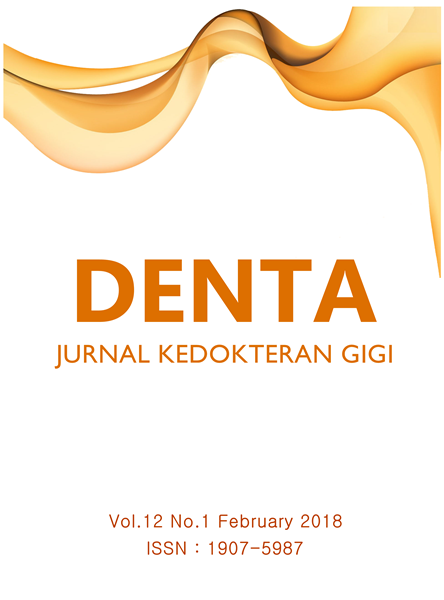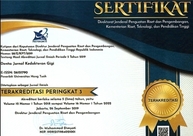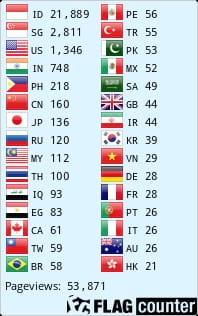The Difference of Impact Strength in Acrylic Resin Self-Cured with the Addition of Zirconium Dioxide (ZrO2) Nanoparticles
Keywords:
Self cured acrylic resin, zirconium dioxide, impact strengthAbstract
Background: Self-cured acrylic resin is a material used for repairing broken and fractured dentures. Zirconium dioxide (ZrO2) is a reinforcing material that is being developed as an additive to the acrylic resin. Purpose: to determine the effect of zirconium dioxide (ZrO2) addition on self-cured acrylic resin on impact strength. Material and Methods: This study was a true experimental laboratory study with the design of a post-test only control group design, using 24 pieces of self-cured acrylic resin measuring 65 x 10 x 2.5 mm divided into 4 groups with and without zirconium addition dioxide (ZrO2) nanoparticles. Zirconium dioxide (ZrO2) nanoparticles were silanized first by mixing the silane coupling agent. Furthermore, the impact strength was tested on the plate. The data obtained were analyzed using the One Way ANOVA test. Results: there were significant differences in the impact strength between the groups with a significance value of 0,000 (p <0.05). Conclusion: there was a difference in the increase of impact strength in acrylic resin self-cured with the addition of ZrO2 nanoparticles concentrations of 3%, 5%, and 7%.
Downloads
References
Dama C, Soelioangan S, Tumewu E. Pengaruh Perendaman Plat Resin Akrilik dalam Ekstrak Kayu Manis (Cinnamomum burmanii) terhadap Jumlah Blastospora Candida Albicans. Jurnal e-Gigi (eG). 2013;1(2):5-1.
Anusavice KJ, Shen C, dan Rawls HR. Phillips Science of Dental Material, 12th ed. Philadelphia: W.B. Saunders Co.;2013. p. 43-724.
Craig GR. Dental Materials: Propeties and Manipulation. 8th Ed; 2004. p. 186-200.
Anusavice KJ. Phillips’ Science of Dental Materials. 10th Ed. New Delhi: Elvesier; 2004. p. 9-75, 85-92,62-155, 6-164, 6-734.
Hatrick CD, Eakle WS, Bird WF. Dental Material Clinical Applications for Dental Assistants and Dental Hygienist, 2nd ed. Missouri: Elsevier, Saunders; 2011. p. 23-217.
Irfandy, Dharmautama M, Damayanti I. Stabilitas Warna Basis Akrilik Gigi Tiruan Lepasan setelah Pembersihan dengan Ekstrak dan Infusa Bunga Rosella. Journal of Dentomaxillofacial. 2014; 13(1):38-42.
Budiharjo A, Wahyuningtyas E, Sugiatno E. Pengaruh Lama Pemanasan Pasca Polimerisasi dengan Microwave terhadap Monomer Sisa dan Kekuatan Transversa pada Reparasi Plat Gigi Tiruan Resin Akrilik. J Ked Gi. 2014;5(2): 13-1.
Agarwal M, Nayak A, Hallikerimath RB. A Study to Evaluate the Transverse Strength of Repaired Acrylic Denture Resins with Conventional Heat-Cured, Autopolymerizing and Microwave-Cured Resins: An in vitro study. J Indian Prosthodont Soc. 2008;8: 41-36.
Arundati R, Patil NP. An Investigation into the Transverse and Impact Strength of a New Indegenious High-Impact Denture Base Resin, DPI-tuff and its Comparison with Most Commonly Used Two Denture Base Resins. J Indian Prothodont Soc. 2006;6(3):133-8.
Powers JM, Wataha JC. Dental Materials Propertiesand Manipulation. 9th Ed. Missouri: Mosby Elsevier;2008. p. 93-286, 299-300.
Manappalil JJ. Basic Dental Materials. 2nd Ed. India: Jaypee Brothers Medical Pub Ltd.;2010. p. 399-400.
Noort RV. Introduction to Dental Materials. 3rd Ed. China : Mosby Elseveir; 2007. p. 211-214.
Ahmed MA, Ebrahim MI. Effect of Zirconium Oxide Nano-Fillers Addition on the Flexural Strength, Fracture Toughness, and Hardness of Heat-Polymerized Acrylic Resin. World Journal of Nano Science and Engineering. 2014;4:57-50.
Dahar E, Handayani S. Pengaruh Penambahan Zirkonium Oksida pada Bahan Basis Gigi Tiruan Resin Akrilik Polimerisasi Panas terhadap Kekuatan Impak dan Transversal. Jurnal Ilmiah PANNMED. 2017;12(2): 194-9.
Dahar E, Laily AN. Pengaruh Penambahan Zirkonium Oksida dan Serat Kaca pada Bahan Basis Gigi Tiruan Resin Akrilik Polimerisasi Panas terhadap Kekuatan Impak dan Transversal. Jurnal Ilmiah PANNMED. 2017;12(2):160-154.
Ihab NS, Moudhaffar MA. Evaluation the Effect of Modified Nano-fillers Addition on Some Properties of Heat Cured Acrylic Denture Base Material. J Bagh College Dent. 2011;23(3):29-23.
Hameed HK, Rahman HA. The effect of Addition Nano Particle ZrO2 on Some Properties of Autoclave Processed Heat Cure Acrylic Denture Base Material. J Bagh College Dent. 2015;27(1): 39-32.
Alla RK, Sajjan S, Alluri VR. Influence of Fiber Reinforcement on the Properties of Denture Base Resins. Journal of Biometerials and Nanobiotechnology. 2013;4: 91-7.
Salman TA, Khalaf HA. The Influence of Adding of Modified ZrO2-TiO2 Nanoparticels on Certain Physical and Mechanical Properties of Heat Polymerized Acrylics Resin. J Bagh College Dent. 2015;27(3):33-9.
Ergun G, Sahin Z, Ataol AS. The Effects of Adding Various Ratios of Zirconium Oxide Nanoparticels to Poly(Methyl Methacrylate) on Physical and Mechanical Properties. Journal of Oral Science. 2018;60(2): 304-15.
Nindha TGT. Biomimetik, Biomaterial, Teknologi Manufaktur Printing 3D. Diktat Teknik Mesin Denpasar: Universitas Udayana. 2017; p.635.
Ferasima R. Pengaruh Penambahan Serat Kaca dan Serat Polietilen terhadap Kekuatan Impak dan Transversal pada Bahan Basis Gigi Tiruan Resin Akrilik Polimerisasi Panas. IDJ. 2013;2(1): 36-27.
Gad MM, Rahoma A, Thobity AM , ArRejaie AS. Influence of Incorporation of ZrO2 nanoparticles on the Repair Strength of Polymethyl Methacrylate Denture Base. International Journal of Nanomedicine. 2016;11:5633-43.
Downloads
Published
How to Cite
Issue
Section
License
Copyright (c) 2018 Universitas Hang Tuah

This work is licensed under a Creative Commons Attribution-ShareAlike 4.0 International License.
Dengan menggunakan Hak Lisensi (sebagaimana didefinisikan di bawah), Anda menerima dan setuju untuk terikat oleh syarat dan ketentuan Lisensi Publik Internasional Creative Commons Atribusi-BerbagiSerupa 4.0 ini ("Lisensi Publik"). Sejauh Lisensi Publik ini dapat diartikan sebagai suatu kontrak, Anda diberikan Hak Lisensi dengan mempertimbangkan penerimaan Anda terhadap syarat dan ketentuan ini, dan Pemberi Lisensi memberikan Anda hak tersebut dengan mempertimbangkan manfaat yang diterima Pemberi Lisensi dari penyediaan Materi Berlisensi berdasarkan syarat dan ketentuan ini.
Bagian 1 – Definisi.
- Materi Adaptasi berarti materi yang tunduk pada Hak Cipta dan Hak Serupa yang berasal dari atau berdasarkan Materi Berlisensi dan di mana Materi Berlisensi tersebut diterjemahkan, diubah, disusun, ditransformasi, atau dimodifikasi dengan cara lain yang memerlukan izin berdasarkan Hak Cipta dan Hak Serupa yang dimiliki oleh Pemberi Lisensi. Untuk tujuan Lisensi Publik ini, jika Materi Berlisensi berupa karya musik, pertunjukan, atau rekaman suara, Materi Adaptasi selalu diproduksi di mana Materi Berlisensi tersebut disinkronkan dalam hubungan waktu dengan gambar bergerak.
- Lisensi Adaptor berarti lisensi yang Anda terapkan pada Hak Cipta dan Hak Serupa dalam kontribusi Anda pada Materi Adaptasi sesuai dengan syarat dan ketentuan Lisensi Publik ini.
- Lisensi Kompatibel BY-SA berarti lisensi yang tercantum di creativecommons.org/compatiblelicenses , yang disetujui oleh Creative Commons sebagai padanan hakiki dari Lisensi Publik ini.
- Hak Cipta dan Hak Serupa berarti hak cipta dan/atau hak serupa yang berkaitan erat dengan hak cipta, termasuk, namun tidak terbatas pada, hak pertunjukan, hak siaran, hak rekaman suara, dan Hak Basis Data Sui Generis, tanpa memperhatikan bagaimana hak tersebut diberi label atau dikategorikan. Untuk tujuan Lisensi Publik ini, hak-hak yang disebutkan dalam Pasal 2(b)(1)-(2) bukan merupakan Hak Cipta dan Hak Serupa.
- Langkah-Langkah Teknologi yang Efektif berarti langkah-langkah yang, jika tidak ada kewenangan yang tepat, tidak dapat dielakkan berdasarkan hukum yang memenuhi kewajiban berdasarkan Pasal 11 Perjanjian Hak Cipta WIPO yang diadopsi pada tanggal 20 Desember 1996, dan/atau perjanjian internasional serupa.
- Pengecualian dan Batasan berarti penggunaan wajar, perlakuan wajar, dan/atau pengecualian atau batasan lain terhadap Hak Cipta dan Hak Serupa yang berlaku untuk penggunaan Anda atas Materi Berlisensi.
- Elemen Lisensi berarti atribut lisensi yang tercantum dalam nama Lisensi Publik Creative Commons. Elemen Lisensi dari Lisensi Publik ini adalah Atribusi dan Berbagi Serupa.
- Materi Berlisensi berarti karya seni atau sastra, basis data, atau materi lain yang kepadanya Pemberi Lisensi menerapkan Lisensi Publik ini.
- Hak Berlisensi berarti hak yang diberikan kepada Anda sesuai dengan syarat dan ketentuan Lisensi Publik ini, yang terbatas pada semua Hak Cipta dan Hak Serupa yang berlaku untuk penggunaan Anda atas Materi Berlisensi dan yang Pemberi Lisensi berwenang untuk melisensikannya.
- Pemberi lisensi berarti individu atau badan yang memberikan hak berdasarkan Lisensi Publik ini.
- Berbagi berarti menyediakan materi kepada publik melalui cara atau proses apa pun yang memerlukan izin berdasarkan Hak Lisensi, seperti reproduksi, tampilan publik, pertunjukan publik, distribusi, penyebaran, komunikasi, atau impor, dan menyediakan materi kepada publik termasuk dengan cara yang memungkinkan anggota publik mengakses materi tersebut dari suatu tempat dan pada waktu yang mereka pilih sendiri.
- Hak Basis Data Sui Generis berarti hak-hak selain hak cipta yang timbul dari Direktif 96/9/EC Parlemen Eropa dan Dewan tanggal 11 Maret 1996 tentang perlindungan hukum basis data, sebagaimana telah diubah dan/atau digantikan, serta hak-hak lain yang pada hakikatnya setara di mana pun di dunia.
- Anda berarti individu atau entitas yang menjalankan Hak Lisensi berdasarkan Lisensi Publik ini. "Anda" memiliki arti yang sesuai.
Bagian 2 – Ruang Lingkup.
- Pemberian lisensi .
- Tunduk pada syarat dan ketentuan Lisensi Publik ini, Pemberi Lisensi dengan ini memberikan Anda lisensi yang berlaku di seluruh dunia, bebas royalti, tidak dapat disublisensikan, tidak eksklusif, dan tidak dapat dibatalkan untuk melaksanakan Hak Lisensi dalam Materi Berlisensi untuk:
- memperbanyak dan Membagikan Materi Berlisensi, secara keseluruhan atau sebagian; dan
- memproduksi, memperbanyak, dan Berbagi Materi yang Diadaptasi.
- Exceptions and Limitations. For the avoidance of doubt, where Exceptions and Limitations apply to Your use, this Public License does not apply, and You do not need to comply with its terms and conditions.
- Term. The term of this Public License is specified in Section 6(a).
- Media and formats; technical modifications allowed. The Licensor authorizes You to exercise the Licensed Rights in all media and formats whether now known or hereafter created, and to make technical modifications necessary to do so. The Licensor waives and/or agrees not to assert any right or authority to forbid You from making technical modifications necessary to exercise the Licensed Rights, including technical modifications necessary to circumvent Effective Technological Measures. For purposes of this Public License, simply making modifications authorized by this Section 2(a)(4) never produces Adapted Material.
- Downstream recipients.
- Offer from the Licensor – Licensed Material. Every recipient of the Licensed Material automatically receives an offer from the Licensor to exercise the Licensed Rights under the terms and conditions of this Public License.
- Additional offer from the Licensor – Adapted Material. Every recipient of Adapted Material from You automatically receives an offer from the Licensor to exercise the Licensed Rights in the Adapted Material under the conditions of the Adapter’s License You apply.
- No downstream restrictions. You may not offer or impose any additional or different terms or conditions on, or apply any Effective Technological Measures to, the Licensed Material if doing so restricts exercise of the Licensed Rights by any recipient of the Licensed Material.
- No endorsement. Nothing in this Public License constitutes or may be construed as permission to assert or imply that You are, or that Your use of the Licensed Material is, connected with, or sponsored, endorsed, or granted official status by, the Licensor or others designated to receive attribution as provided in Section 3(a)(1)(A)(i).
- Tunduk pada syarat dan ketentuan Lisensi Publik ini, Pemberi Lisensi dengan ini memberikan Anda lisensi yang berlaku di seluruh dunia, bebas royalti, tidak dapat disublisensikan, tidak eksklusif, dan tidak dapat dibatalkan untuk melaksanakan Hak Lisensi dalam Materi Berlisensi untuk:
-
Other rights.
- Moral rights, such as the right of integrity, are not licensed under this Public License, nor are publicity, privacy, and/or other similar personality rights; however, to the extent possible, the Licensor waives and/or agrees not to assert any such rights held by the Licensor to the limited extent necessary to allow You to exercise the Licensed Rights, but not otherwise.
- Patent and trademark rights are not licensed under this Public License.
- To the extent possible, the Licensor waives any right to collect royalties from You for the exercise of the Licensed Rights, whether directly or through a collecting society under any voluntary or waivable statutory or compulsory licensing scheme. In all other cases the Licensor expressly reserves any right to collect such royalties.
Section 3 – License Conditions.
Your exercise of the Licensed Rights is expressly made subject to the following conditions.
-
Attribution.
-
If You Share the Licensed Material (including in modified form), You must:
- retain the following if it is supplied by the Licensor with the Licensed Material:
- identification of the creator(s) of the Licensed Material and any others designated to receive attribution, in any reasonable manner requested by the Licensor (including by pseudonym if designated);
- a copyright notice;
- a notice that refers to this Public License;
- a notice that refers to the disclaimer of warranties;
- a URI or hyperlink to the Licensed Material to the extent reasonably practicable;
- indicate if You modified the Licensed Material and retain an indication of any previous modifications; and
- indicate the Licensed Material is licensed under this Public License, and include the text of, or the URI or hyperlink to, this Public License.
- retain the following if it is supplied by the Licensor with the Licensed Material:
- You may satisfy the conditions in Section 3(a)(1) in any reasonable manner based on the medium, means, and context in which You Share the Licensed Material. For example, it may be reasonable to satisfy the conditions by providing a URI or hyperlink to a resource that includes the required information.
- If requested by the Licensor, You must remove any of the information required by Section 3(a)(1)(A) to the extent reasonably practicable.
-
- ShareAlike.
In addition to the conditions in Section 3(a), if You Share Adapted Material You produce, the following conditions also apply.
- The Adapter’s License You apply must be a Creative Commons license with the same License Elements, this version or later, or a BY-SA Compatible License.
- You must include the text of, or the URI or hyperlink to, the Adapter's License You apply. You may satisfy this condition in any reasonable manner based on the medium, means, and context in which You Share Adapted Material.
- You may not offer or impose any additional or different terms or conditions on, or apply any Effective Technological Measures to, Adapted Material that restrict exercise of the rights granted under the Adapter's License You apply.
Section 4 – Sui Generis Database Rights.
Where the Licensed Rights include Sui Generis Database Rights that apply to Your use of the Licensed Material:
- for the avoidance of doubt, Section 2(a)(1) grants You the right to extract, reuse, reproduce, and Share all or a substantial portion of the contents of the database;
- if You include all or a substantial portion of the database contents in a database in which You have Sui Generis Database Rights, then the database in which You have Sui Generis Database Rights (but not its individual contents) is Adapted Material, including for purposes of Section 3(b); and
- You must comply with the conditions in Section 3(a) if You Share all or a substantial portion of the contents of the database.
For the avoidance of doubt, this Section 4 supplements and does not replace Your obligations under this Public License where the Licensed Rights include other Copyright and Similar Rights.
Section 5 – Disclaimer of Warranties and Limitation of Liability.
- Unless otherwise separately undertaken by the Licensor, to the extent possible, the Licensor offers the Licensed Material as-is and as-available, and makes no representations or warranties of any kind concerning the Licensed Material, whether express, implied, statutory, or other. This includes, without limitation, warranties of title, merchantability, fitness for a particular purpose, non-infringement, absence of latent or other defects, accuracy, or the presence or absence of errors, whether or not known or discoverable. Where disclaimers of warranties are not allowed in full or in part, this disclaimer may not apply to You.
- To the extent possible, in no event will the Licensor be liable to You on any legal theory (including, without limitation, negligence) or otherwise for any direct, special, indirect, incidental, consequential, punitive, exemplary, or other losses, costs, expenses, or damages arising out of this Public License or use of the Licensed Material, even if the Licensor has been advised of the possibility of such losses, costs, expenses, or damages. Where a limitation of liability is not allowed in full or in part, this limitation may not apply to You.
- The disclaimer of warranties and limitation of liability provided above shall be interpreted in a manner that, to the extent possible, most closely approximates an absolute disclaimer and waiver of all liability.
Section 6 – Term and Termination.
- This Public License applies for the term of the Copyright and Similar Rights licensed here. However, if You fail to comply with this Public License, then Your rights under this Public License terminate automatically.
-
Where Your right to use the Licensed Material has terminated under Section 6(a), it reinstates:
- automatically as of the date the violation is cured, provided it is cured within 30 days of Your discovery of the violation; or
- upon express reinstatement by the Licensor.
- For the avoidance of doubt, the Licensor may also offer the Licensed Material under separate terms or conditions or stop distributing the Licensed Material at any time; however, doing so will not terminate this Public License.
- Sections 1, 5, 6, 7, and 8 survive termination of this Public License.
Bagian 7 – Syarat dan Ketentuan Lainnya.
- Pemberi Lisensi tidak akan terikat oleh ketentuan atau persyaratan tambahan atau berbeda yang dikomunikasikan oleh Anda kecuali disetujui secara tegas.
- Segala pengaturan, kesepahaman, atau perjanjian mengenai Materi Berlisensi yang tidak dinyatakan di sini terpisah dari dan independen dari syarat dan ketentuan Lisensi Publik ini.
Bagian 8 – Interpretasi.
- Untuk menghindari keraguan, Lisensi Publik ini tidak, dan tidak akan ditafsirkan untuk, mengurangi, membatasi, mengekang, atau memaksakan ketentuan pada penggunaan Materi Berlisensi yang secara sah dapat dilakukan tanpa izin berdasarkan Lisensi Publik ini.
- Sedapat mungkin, jika ada ketentuan dalam Lisensi Publik ini yang dianggap tidak dapat diberlakukan, ketentuan tersebut akan secara otomatis direformasi hingga batas minimum yang diperlukan agar dapat diberlakukan. Jika ketentuan tersebut tidak dapat direformasi, ketentuan tersebut akan dihapus dari Lisensi Publik ini tanpa memengaruhi keberlakuan syarat dan ketentuan lainnya.
- Tidak ada syarat atau ketentuan Lisensi Publik ini yang akan diabaikan dan tidak ada kegagalan untuk mematuhi yang disetujui kecuali disetujui secara tegas oleh Pemberi Lisensi.
- Tidak ada satu pun dalam Lisensi Publik ini yang merupakan atau boleh ditafsirkan sebagai pembatasan atau pengesampingan hak istimewa dan kekebalan apa pun yang berlaku bagi Pemberi Lisensi atau Anda, termasuk dari proses hukum di yurisdiksi atau otoritas mana pun.











